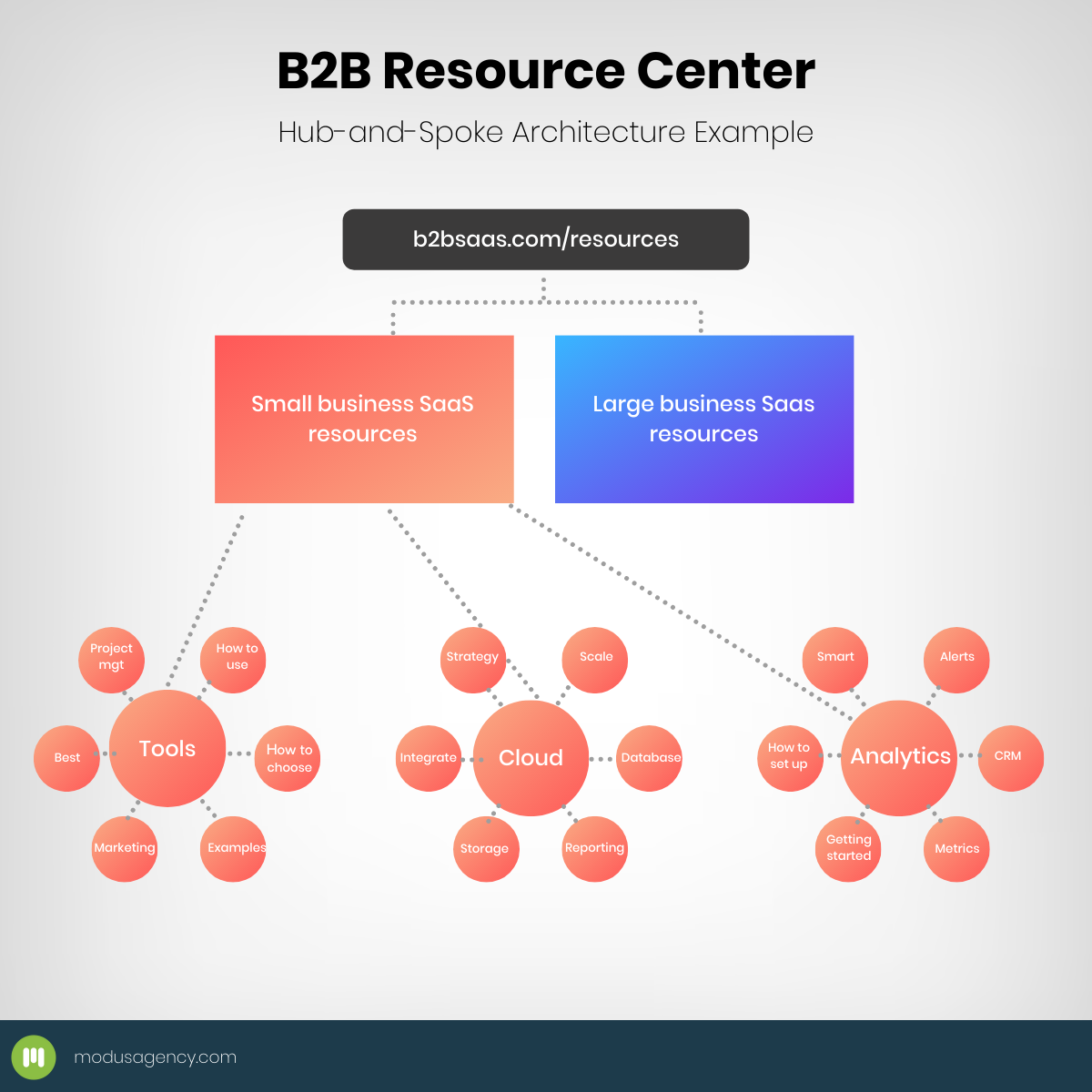How to Optimize a B2B Resource Center with Hub-and-Spoke SEO Strategy

Part II: The content cluster model plays nicely with a hub-and-spoke architecture
If you’re following along, we’re looking at how Modus approached the recent redesign of a large resource hub for one of our Fortune 500 B2B clients that resulted in significantly more organic traffic and sales leads. Be sure to read Part 1, where we break down the process of a substantial content audit and how we tied it to a cluster-based tagging strategy.
Remember, an online resource center is different from a company blog — the newest content doesn’t need to appear first. The reader doesn’t care about your most recent case study or product update when they’ve arrived at your site looking for specific advice. When designed thoughtfully, a resource hub is a strategic portal that drives the customer journey: come for the content, stay for the commerce.
SEO is a key part of driving top-of-tunnel traffic to a resource hub. Readers are in research mode, using keyword searches to find reliable, relevant information to answer their questions and solve pain points. As is the case with many large enterprise firms, SEO is a huge priority for our client. So we were fortunate to partner with the client’s internal team driving SEO strategy throughout this project.
As the resource center redesign got underway, our client requested an SEO-focused architecture to support their content strategy. The internal team had already determined short- and long-tail keywords for the article pages and created content incorporating those high-volume and niche terms. Our job was to ensure the content in the resource center mapped to a “hub-and-spoke” site structure for maximum engagement.
What is a hub-and-spoke SEO model?
In the past, search engines matched queries to keywords on web pages. Over time, Google’s algorithm has come to favor topics over keywords as signals of user intent. The hub-and-spoke model is a way of organizing content around topics, making it easier for search engines and visitors to find and use a website.
Hub pages (also known as pillar pages) are comprehensive guides on evergreen topics that readers want to learn about and your organization wants to build authority for. These pages include links to subpages that dive into narrower aspects (i.e., long-tail keywords) of the hub topic. To promote engagement, subpages link back to the hub content, like spokes on a wheel. Strategic internal linking also helps search engines determine how pages and topics are related and recognize how deep your content goes.
The benefit of this model, in addition to organizing your site architecture, is that one high-performing subpage page can elevate search rankings for all the other pages linked to the same hub. And as the hub pages increase in authority, they pull the subpages up with them.

1. Bucket the hubs for personalized content libraries
Initially, the content within our client’s B2B resource center was organized by asset type — case studies, articles, and calculators, for example. There was no contextual hierarchy that would help tell the user which information was timely, important, or popular. Often, the client marketing team would spin up themed microsites and landing pages with curated content to meet specific campaign needs, adding to site sprawl.
Persona and buyer journey research showed the audience’s needs and interests differed greatly depending on business size, so we updated the sitemap to branch the resource center content into two buckets — one for small businesses and one for midsized-to-large businesses. The design, color scheme, and images are differentiated for the content within each segment, further signaling to the reader that, however they’ve arrived, they’re in the right place. We also created a color scheme for assets that belonged to both buckets. This personalized approach encourages the user to spend more time on the site, click to more pages, and consume content to their heart’s content.
After dividing by size, we determined the topic clusters for each segment. As we covered in Part 1, with our thorough content audit using Airtable, we tagged each article to match a topic cluster. These clusters are based on the primary needs of the audience that relate to the client’s key product and service lines, core values, and expertise. Looking at the content audit in Airtable, we were easily able to filter and ensure that each cluster had enough content to fill our topic hubs.
2. Set the stage — the buyer stage
Once again, all that hard work we did during the content audit paid off when we tagged each asset according to buyer stage (learn, evaluate, decide). While hub pages are typically ungated, top-of-funnel educational guides, they can strategically link to mid- and down-funnel content where a prospect may need to complete a form to keep reading. High-value resources, such as comprehensive ebooks that help users solve complex problems or make strategic buying decisions, are good candidates for gating behind a form.
There are many ways to promote gated subpages on hub pages. Examples include calls to action (CTAs) that are textual links that appear in-line, usually after 20% of the way down an article, graphic CTA banners that can live in sidebars or near the footer, or exit intent pop-ups, just to name a few. Of course, CTAs like this might turn off readers, depending on the type of content — this is where conscientious lead gen strategy comes into play.
We’re currently working with the client to test CTA placement and conversion rate optimization throughout the resource center, but the idea is to nurture soft leads (visitors that may not be ready to buy) with thoughtful content marketing. Dynamically changing CTAs, such as an email opt-in for the user’s first vs. a webinar promo on a return visit, are just one example of conversion optimization events that can be tested.
3. Crosslink the subs
Once we had our site architecture and content marketing framework in place, then came the fun part for our designers — building article page templates. For a hub-and-spoke content model, the basic gist is that hub pages connect to subpages and vice versa, but there are many ways to approach this. Best practices include breadcrumb navigation links, sidebar navigation, table of contents, in-line links, and footer links. They all serve the purpose of helping readers navigate to information that meets their needs, as well as helping the business drive toward desired outcomes. Some examples of sites that handle resource hub link optimization really well include REI’s expert advice hub, Corporate Finance Institute’s resource center, and Unilever’s All Things Hair content hub.
Remember, content hubs drive link authority and topical relevance from the subpages to the hub pages. If your hub page is linked to from a large number of subpages on your site, that signals to Google that the page is pretty important.
Keep it simple
With Google’s page experience update (Core Web Vitals) rolling out, it’s crucial that your website offers a user-friendly experience. The hub-and-spoke model is a simple way to organize large portals of content so that readers can easily find what they are looking for. Stay tuned for the final chapter in this story to learn how UX component design added to the successful rollout of this large-scale resource center redesign.



